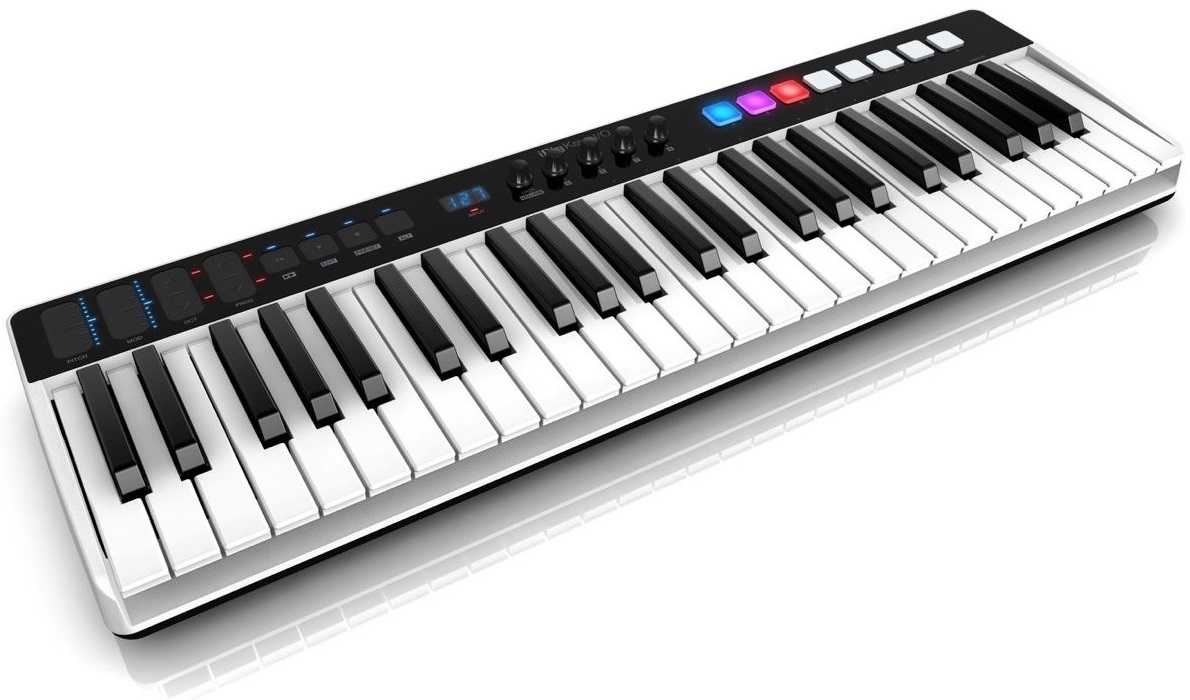Streamline your studio with the iRig Keys I/O

The new MIDI controllers from IK Multimedia add an audio interface to a fully capable USB controller. Whether you’re recording a masterpiece for Soundcloud, or demo-ing a song for your band, you’ll more than likely need a few things to connect to your computer. If you’re looking at vocals or real instruments, you’ll need an interface that can turn your analog sounds into digital ones. Personally, I run an M-Audio MobilePre USB for that task, and they go for about $180 on Amazon. Additionally, you’d probably like to have a MIDI controller in order to ‘play’ all the sounds you don’t have real instruments for. These can run you anywhere between $250-500, depending on what features you’re after. At $300, the iRig Keys I/O 49 from IK Multimedia sits comfortably at the lower end of the bracket.
As can be seen from the name, this is a MIDI controller with 49 full-size piano keys, and one more important feature: it comes with a built-in audio interface that can record a whopping 24-bit audio at 96kHz sampling rate. As you’d expect of other similar controller, the iRig Keys I/O can work with PC, Mac, iOS devices, and whatever software you’re familiar with. Power is provided via the USB from your computer, four AA batteries, or a DC charger (not included). All these power options make it a super-portable solution.
You’ll find the iRig Keys’ physical layout quite intuitive, with big, easy-to-access controller buttons, knobs, as well as touch-sensitive sliders placed above the piano keys. As seen in most MIDI controllers, you have all the usual complement of modulation controls, pitch shifters, velocity-sensitive pads, and other programmable buttons.
I’ve always been a fan of controlling the various sounds I’m playing on a keyboard through physical controls, and in the iRig I found them all laid out intuitively: sliders on the left, knobs in the center, pads on the right. Everything is nicely labeled for daytime use, but you’ll have to learn your way around if you’re playing in a dark bar or recording studio – none of these labels light up.
The iRig I/O 49 covers all of its bases with the ports and switches on the back. There’s a USB power toggle, a DC port, and a Mini –DIN MIDI port for the includes USB or lightning cables that connect your device and keyboard together. Of course, there’s the h eadphone jack and balanced outputs for when you connect an amp or PA.
The device loses a bit of its higher-end feel when it comes to the keys, as they’re plastic and unweighted. Despite that, the playing the iRig Keys feels as good as any other USB controller I’ve tried out. Overall the build quality is reasonably high-end, including the soft rubber feet applied to the bottom to stop it slipping & sliding around the table. If you’ve ever tried to hit chords on a mini-rig, you’ll really appreciate the joy that you feel when you play on keys that are the same size as a real piano. My fat fingers aren’t a problem here!
When it comes down to it, MIDI controllers are only as good as the software they can access. iRig Keys I/O comes with its own decent apps for PC/Mac and iOS, such as Ableton Live 9 Lite, Studio One Prime, and IK Multimedia’s own SampleTank. With your purchase you’ll also net yourself a couple of different synth & orchestral sound banks, as well as the T-Racks mastering software (coming in at $300 value by itself.) All this software is a great place to start if you don’t already have your own preferred music-making software or apps – however it was a bit tedious sourcing sounds from SampleTank on the Mac, mostly due to multipart downloads.
The system I’m most familiar with these days is GarageBand on Mac and iOS. A simple plug and play affair, connecting the controller brought no problems. In fact, not worrying about any extra dongles, cables, or power plugs was a delight. Simply sit down, plug the iRig Keys into my iPad, and I could hit the ground running, playing orchestral and electronic sounds within seconds.
I’ve used quite a few MIDI controllers over the years, connecting keyboards both large & small to my iOS devices and my Macs. I’ve toyed with small-footprint tiny keyboards. I’ve experienced full-size, full-weighted keyboards that require a separate MIDI box to connect. I’ve found myself recording in decent-sized home studios with input racks, mixers, and all sorts of other expensive kit. I’ve also recorded in tiny apartments, with cords strung all over the place.
These days, this is what I typically go through – I connect my microphone, bass or guitar to my Mac via a basic USB audio interface. My full-size Roland synth (doubling as a controller) lets me lay down unearthly-sounding pads and strings, alongside a heap of instruments I don’t have at the ready, such as woodwinds or horns. This process typically involves quite a bit of unpacking, setting up on the table, and putting away when finally done.
Most of my excitement around the iRig I/O is the ability to have just one main box on the table, powered by USB. A quick plug in of an iPhone, guitar or bass into the keyboard, and I can monitor through either the unit itself via headphones, or a little accompanying studio monitor. When wrapping up, simply unplug a couple cables, lean the iRig up against the wall, and done. With 49 keys, I can easily stretch out across several octaves, and its small footprints allows me to create a reasonably competent home studio on a coffee table.
I’m also looking forward to taking this live – we already have a full-size instrument and keyboard player on stage, but the ability to drop in a some AA batteries, hook up the iRig Keys to my iPhone, and pump out a few extra sounds – that’s a great thing. Additionally, the practice studio isn’t massive, so this appeals when you’ve already got a guitar, pedalboard, and microphone in front of you.
Ultimately, all this potential and ability leads us to a streamlined, and very capable rig when it comes to both recording and performing. Let’s also remind ourselves that it’s only $300. I almost paid that for my studio’s current interface, and it lacks a programmable MIDI keyboard controller. Maybe you’re like me, and making music quickly, and in a tight space, is what you do. The iRig Keys I/O makes this far easier, and nicer on the wallet.



